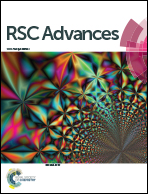Modeling and optimization of Hg2+ ion biosorption by live yeast Yarrowia lipolytica 70562 from aqueous solutions under artificial neural network-genetic algorithm and response surface methodology: kinetic and equilibrium study
Abstract
This study was devoted to the investigation of Hg2+ ion biosorption by a live yeast organism, namely, Yarrowia lipolytica 70562 (supplied commercially), which was sufficiently identified and studied by SEM-EDS and FT-IR methods. Dependency and relation among experimental parameters and conventional experimental conditions such as pH, concentration of Hg2+ ion, contact time and temperature were examined. Subsequently, these parameters were modeled and the optimum conditions were determined accordingly. It was found that the real experimental data with high efficiency can be represented and explained by the ANN-GA model and response surface methodology. Furthermore, kinetic and isotherm models under the optimum conditions obtained from ANN-GA were studied. Lateral studies reveal that a pseudo-second order kinetic model, an intraparticle diffusion model and a Langmuir model are good and efficient models for representation and explanation for the experimental result trends.


 Please wait while we load your content...
Please wait while we load your content...